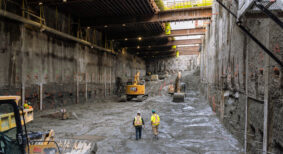Construction across Canada is expected to rebound in 2021 in the wake of the COVID-19 pandemic and rise through the coming decade, according to the latest labour market forecast released by BuildForce Canada.
The strength and pace of recovery, however, will vary among provinces, and will depend significantly on the rollout of COVID-19 vaccines, the recovery in consumer and business confidence, the global demand for Canadian exports, and the lifting of restrictions on international travel.
BuildForce Canada’s 2021–2030 Construction and Maintenance Looking Forward national report forecasts construction employment to rise by 64,900 workers over the next decade. This represents an increase of 6 per cent over 2020 workforce levels. While the outlook forecasts much of that growth to take place through 2025, by the end of the decade, the respective provincial industries will have to cope with the need to replace nearly 259,100 workers, or about 22 per cent of the current labour force, due to retirement.
“Canada’s construction outlook is strong for 2021 and well into the middle portion of the decade thanks to gains in the residential and non-residential sectors,” says BuildForce Canada executive director Bill Ferreira. “And while we forecast growth to slow over the later years of our forecast period, we nonetheless expect that the industry will be challenged to recruit more than 309,000 new workers to replace retirees and keep pace with demand.”
BuildForce Canada anticipates that the non-residential sector will lead industry growth between 2021 and 2023 and be driven by a large list of public transit, health care, education, roadwork, and other civil infrastructure projects. Overall, non-residential employment is projected to increase by more than 39,800 workers between 2021 and 2025, and another 5,000 to 2030.
The sector is expected to end the decade up 44,800 workers (up 8 per cent) compared to 2020.
In B.C., construction is poised to enter the steepest period of growth in its forecast period. The province will add more than 11,400 non-residential workers through 2022, before shedding as many as half of those gains through 2026, before renewed growth later in the period adds new jobs. By 2030, employment is expected to increase by 9,900 workers compared to 2020.
Alberta, which was among the provinces hardest hit by the pandemic, could see further challenges ahead. Ongoing uncertainty in the energy sector and further deferrals and cancellations of major investments have significantly tempered expectations for a strong near-term recovery. A more material expansion is expected after 2023.
Ontario will be driven by a growing pipeline of major infrastructure projects across all regions. An additional recovery in commercial and industrial investment will bring labour demands to a peak in 2026.
“The unevenness with which provinces and even regions within those provinces will experience construction growth over the forecast period suggests that intra- and interprovincial mobility, as well as drawing workers from other industries, will be key to meeting construction demands,” says Ferreira.









